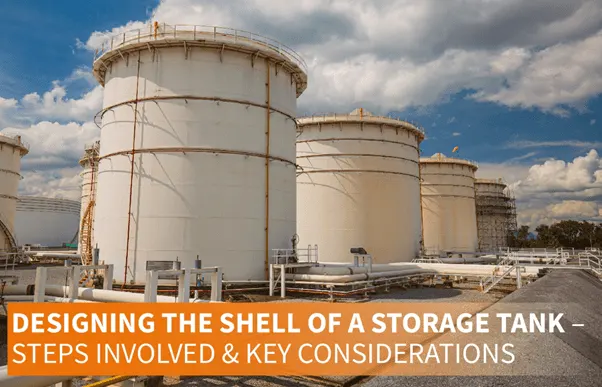Designing the Shell of a Storage Tank
Steps Involved and Key Considerations

Storage tanks are containers used to store a variety of liquids. They are designed to meet the specific requirements of different industries and come in various shapes and sizes.
One of the most common Industry used codes for designing and engineering storage tank is the API 650. The API 650 standard provides guidelines for the design, fabrication, and inspection of welded storage tanks.
Shell Design:
The shell is one of the significant components of a storage tank. It is usually made up of adding multiple shell courses. These are prepared by bending carbon steel, stainless steel, and aluminium plates by forming curvature to achieve the required diameter. API 650 provides some guidelines to evaluate the shell thickness of various shell courses as per tank sizing and process parameters.
Parameters crucial for Shell thickness:
1Hydro-Static Head:
- hydro-static head plays a vital role while defining the shell thickness. It is the maximum height up to which liquid can be filled.
- A higher static head will increase shell course thickness.
2Design pressure and Temperature:
- Design pressure is the maximum pressure up to which the tank is designed. It is further added to a hydro-static head during shell thickness evaluation.
3Design temperature:
- Design temperature is also one of the crucial factors in shell thickness design. However, the higher temperature in storage tanks above API 650 limit will require an increased shell thickness.
4Design Specific Gravity:
- Design-specific gravity is also one of the crucial factors in shell thickness design. However, the denser fluid leads to an increase in shell thickness.
5Corrosion Allowance:
- Corrosion Allowance is further added above required to an increase in shell thickness.
Some key considerations:
Accurate Input:
Ensure accurate data is available, including design pressure and temperature, loads, and material properties. Any errors in the input data can have severe consequences for the stability and reliability of the tank.
Loads:
It is crucial to ensure that the shell is designed to withstand the loads on the shell, including wind, seismic, and hydro-static loads.
Material Selection:
Suitable material for the tank based on the design requirements and the required thickness of the material based on the design pressure and temperature.
Conclusion
The design of the shell of a storage tank is a critical aspect of the overall design of the tank. The API 650 standard provides storage tanks' design, fabrication, and inspection guidelines. It is essential to follow these guidelines to ensure the safe and efficient operation of the tank.
The design of the shell must withstand the design pressure and temperature, selection of material, height, diameter, and the loads the tank will be subjected to.
The above will ensure that your storage tank is designed and engineered to meet your specific requirements and provide reliable and safe storage for your materials
